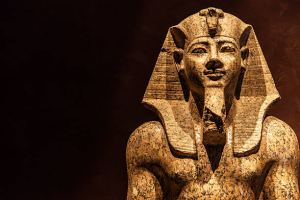Top 10 Interesting Facts about Rangoli
Rangoli, the ancient and vibrant art of creating intricate patterns on the ground, is a cherished tradition in India and various parts of the world. Beyond its ... read more...aesthetic appeal, Rangoli holds a wealth of fascinating facts and cultural significance. In this exploration, we uncover the top 10 interesting facts about Rangoli that shed light on its rich history, diversity, and enduring charm.
-
One of the interesting facts about Rangoli is that symbolic designs play a significant role in Rangoli, the traditional Indian art of creating colorful and intricate patterns on the ground. These symbols are not merely decorative; they carry deep cultural, spiritual, and even religious meanings.
The lotus flower, which stands for purity and enlightenment on a spiritual level, is one of the most prevalent symbols used in Rangoli. The diya, or oil lamp, symbolizes the victory of light over darkness and good over evil, particularly during Diwali, the Festival of Lights. The swastika, an ancient symbol of auspiciousness and good fortune, is used to invite positive energy.
Animals like the peacock and elephant frequently appear. The peacock signifies beauty, grace, and the cycle of rebirth, while the elephant symbolizes wisdom and good luck. Conch shells represent divine communication, while the fish embodies fertility and abundance.
These symbols are carefully chosen to convey wishes, blessings, and cultural values. They add depth and meaning to Rangoli, making it more than just art; it's a form of expression deeply ingrained in the traditions and beliefs of India.
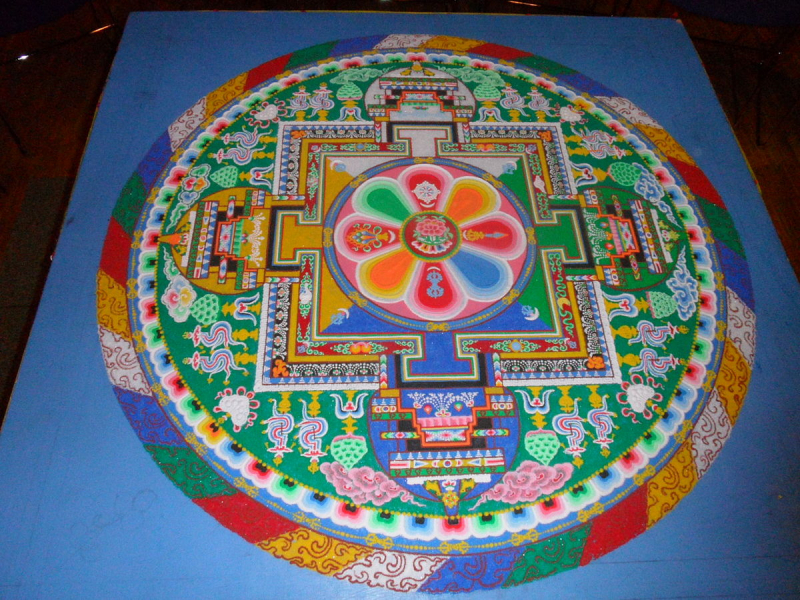
Image from https://commons.wikimedia.org/wiki/File:Mandala_made_at_Prismare_by_Tibetan_monks.JPG Video by KD Gallery -
Rangoli is an ancient and time-honored tradition in India. Its origins can be traced back thousands of years, and it has been an integral part of Indian culture and rituals for generations. The practice of creating intricate and colorful patterns on the ground holds deep historical and cultural significance.
Ancient texts and scriptures mention the art of Rangoli, showcasing its presence in various regions of India since antiquity. Over the centuries, it has evolved, with different styles and techniques emerging in different parts of the country. These styles often reflect the local customs, beliefs, and influences of the region.
Rangoli has not only been a means of artistic expression but also a form of spiritual and cultural significance. It is believed to bring good luck and prosperity to homes, and it is commonly used during religious ceremonies and festivals. The act of creating Rangoli patterns is also considered meditative, providing a sense of peace and tranquility to those who practice it.
Despite the passage of time and modernization, Rangoli remains a cherished and respected tradition in India. It continues to be passed down through generations, preserving the rich heritage and cultural values associated with this ancient art form.
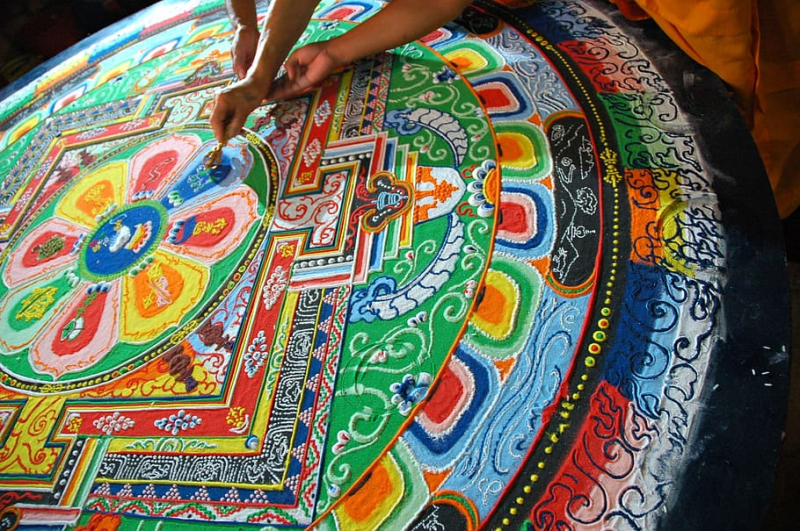
Image from https://www.wallpaperflare.com/nepal-kathmandu-tharlam-monastery-dorje-initation-hands-wallpaper-gsvxj Video by Timeless Wisdom - Food & Lifestyle -
Festival tradition and Rangoli are inseparable in India, where festivals are celebrated with great fervor and color. Rangoli, the art of creating intricate patterns on the ground, is an integral part of these celebrations, serving as a symbol of joy, spirituality, and hospitality.
During festivals like Diwali, the Festival of Lights, Rangoli takes center stage. Elaborate designs are meticulously crafted in front of homes to welcome Goddess Lakshmi and symbolize the triumph of light over darkness. The vibrant colors and patterns create a festive atmosphere that resonates with the spirit of the occasion.
In the southern state of Tamil Nadu, Rangoli is known as "Kolam" and is a vital part of Pongal, the harvest festival. People draw colorful Kolam patterns using rice flour as an expression of gratitude for a bountiful harvest.
During Navaratri in Gujarat, Rangoli patterns are an integral part of the Garba dance celebrations, while in Kerala, the floral Rangoli known as "Pookalam" adorns courtyards during Onam.
These Rangoli designs aren't merely decorations; they are expressions of cultural and spiritual significance. They serve as a warm and inviting gesture, symbolizing the unity and happiness that come with the festival season. Rangoli, in essence, is a visual representation of the vibrancy and diversity of India's rich festival tradition.
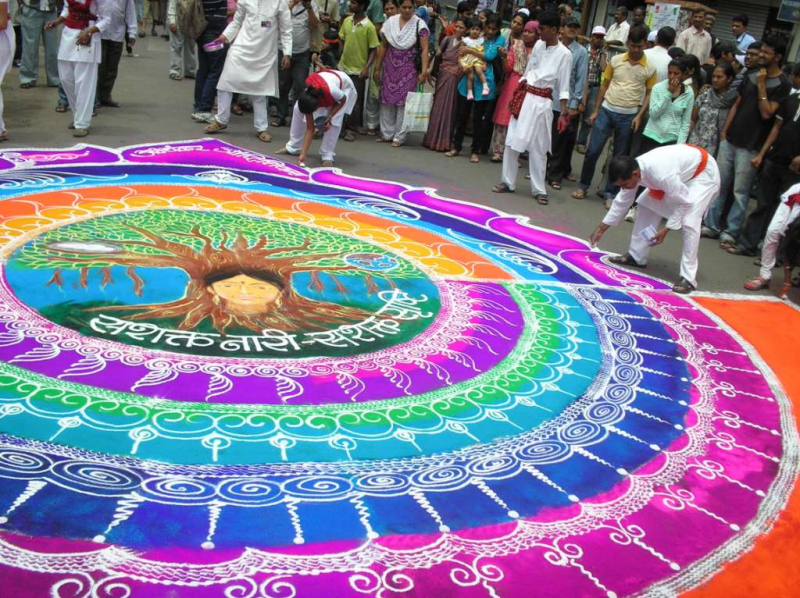
Image from https://www.flickr.com/photos/chocolatecoffeecream/6152048212/in/photostream/ Video by National Geographic -
Rangoli, the traditional Indian art form of creating intricate patterns on the ground, is renowned for its versatile use of materials. These materials span a broad spectrum, showcasing the art's adaptability and regional diversity. Rangoli artists draw from a wide array of resources, selecting materials based on cultural significance, artistic vision, and local availability.
Materials like colored powders, flower petals, and rice grains offer a vibrant and visually appealing palette, often used during festivals and special occasions. Colored sand is another favored medium, particularly for larger and outdoor designs, due to its durability.
Traditional spices like turmeric and vermilion, as well as natural elements like leaves and petals, add a touch of eco-friendliness to Rangoli creations. In the modern era, dyes, food coloring, and stencils provide artists with greater flexibility and precision in design.
Whether it's the fragrant allure of fresh flower petals or the intricate patterns crafted from colored sand, these materials lend depth, texture, and cultural richness to Rangoli. They enable artists to tell stories, convey emotions, and capture the essence of India's diverse cultural traditions through this captivating and ever-evolving art form.
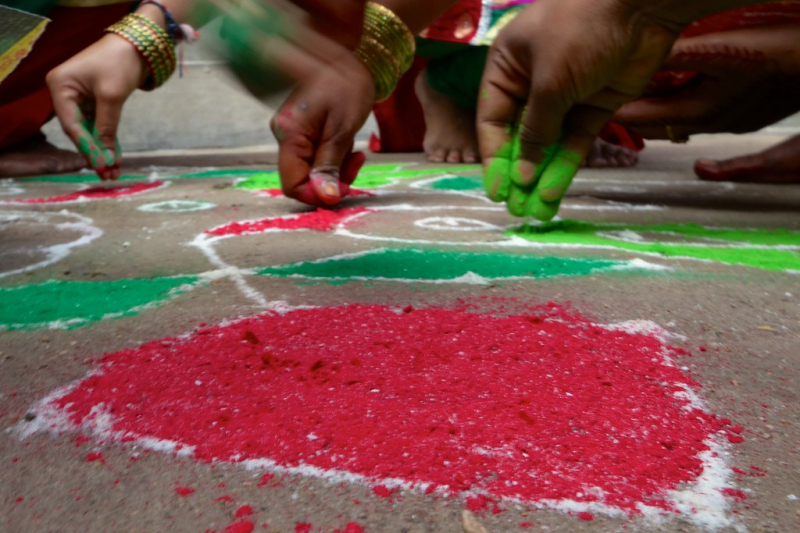
Image from https://www.flickr.com/photos/pamnani/10759449853 Video by Jeet Rangoli -
Regional variations in Rangoli, the traditional Indian art form of creating intricate patterns on the ground, are a testament to the country's rich cultural diversity. Throughout India, different regions have developed their own unique styles and techniques, adding depth and richness to this ancient practice.
In South India, particularly in Tamil Nadu, Rangoli is known as "Kolam." Kolam designs are characterized by their geometric precision and often feature symmetrical patterns created with rice flour.
In West Bengal, it's called "Alpana." Alpana designs are fluid and freehand, often depicting natural motifs like flowers and leaves. Bihar has "Aripana," where wet rice paste is used to create detailed and intricate designs with traditional and religious symbolism.
Andhra Pradesh and Telangana embrace "Muggu," known for its complex patterns drawn with rice flour. Maharashtra boasts "Sanskar Bharti Rangoli," featuring bold, colorful patterns with cultural significance.
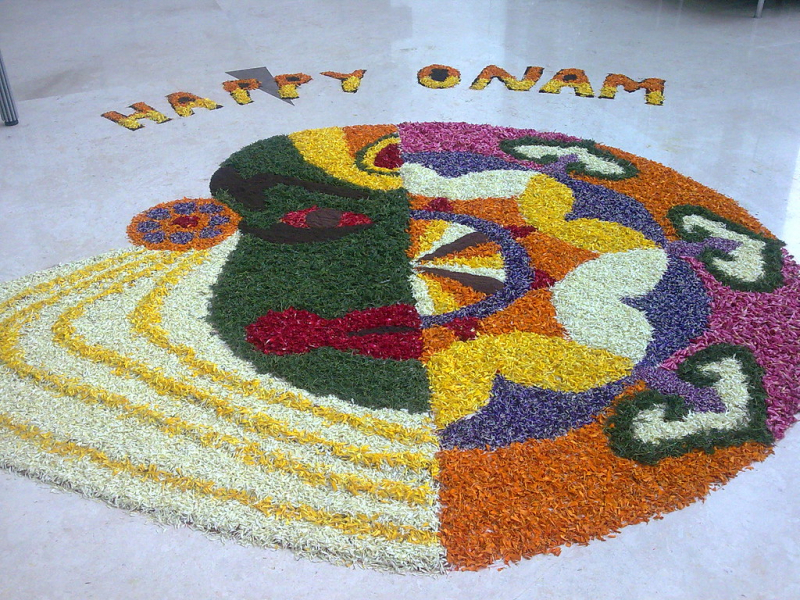
Image from https://www.flickr.com/photos/sunayana-photogallery/4973176729/in/photostream/ Video by Artist Shikha Sharma -
Rangoli, the intricate art of creating colorful patterns on the ground, transcends its role as mere decoration. It embodies a deeper significance as a meditative practice. This centuries-old tradition has a tranquil and introspective quality that goes beyond its visual appeal.
As Rangoli artists meticulously draw lines, curves, and dots to form elaborate designs, they enter a state of focused concentration. The process of creating Rangoli demands attention to detail, patience, and precision. Each stroke and element of the design requires careful consideration, fostering a sense of mindfulness.
This meditative aspect of Rangoli is akin to a form of active meditation. As artists immerse themselves in the rhythmic and repetitive motions, they experience a calming effect on their minds. Rangoli's meditative practice extends beyond the artist, as those who observe the creation of these intricate patterns can also find solace and inspiration in their beauty.
In a fast-paced world, Rangoli offers a serene refuge—a time to connect with one's inner self and the surrounding environment. It exemplifies the idea that art, beyond its aesthetic allure, can be a conduit for inner serenity and a source of meditative reflection.
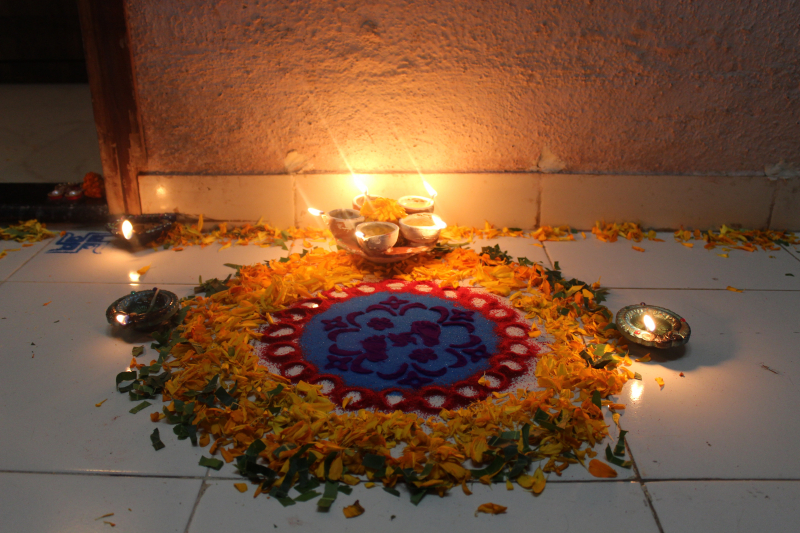
Image from https://pxhere.com/vi/photo/967013 Video by Wellcome Collection -
One eco-friendly aspect of Rangoli lies in the choice of materials. Many Rangoli designs utilize natural substances such as flower petals, rice grains, and leaves. These materials are biodegradable and easily decompose, leaving minimal environmental impact. In some cases, artists use colored powders made from organic sources like spices, adding to their eco-friendly appeal.
Additionally, Rangoli promotes a culture of recycling and repurposing. Some designs incorporate recycled materials like crushed eggshells, used tea leaves, or even discarded bangles, turning waste into artistic beauty. This not only reduces waste but also encourages creative recycling.
The temporary nature of Rangoli is another eco-friendly aspect. These intricate designs are often created on the ground, where wind and rain naturally erase them over time. This impermanence reflects the transient nature of life and art, emphasizing the importance of cherishing the present moment.
Rangoli, as an eco-friendly artistic expression, harmonizes with nature and highlights the significance of sustainable practices in artistic traditions. It serves as a reminder that art and environmental responsibility can coexist, fostering a deeper appreciation for both the natural world and the cultural heritage it inspires.
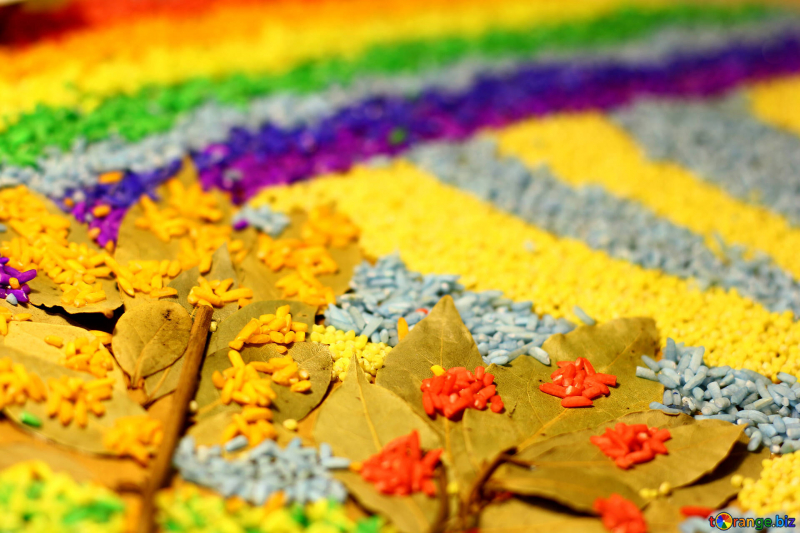
Image from https://torange.biz/childrens-creativity-37196 Video by Ira & Mom -
Rangoli competitions, integral to the tradition, are vibrant events that infuse a competitive spirit into this ancient art form. They serve as a dynamic platform for artists to express their creativity and Rangoli-making skills. These contests are often held during festivals and cultural gatherings and bring together participants from various backgrounds.
Rangoli competitions are much more than artistic showcases; they provide a space for artists to demonstrate their precision, attention to detail, and ability to adapt to specific themes or challenges. Many contests introduce unique themes, encouraging participants to explore different aspects of culture, society, and the environment through their art.
These events not only celebrate the beauty of Rangoli but also foster a sense of community. Spectators gather to admire the artistry and effort put into each design, creating an atmosphere of cultural appreciation and participation. The recognition and prizes awarded to winners serve as motivation for artists to continue refining their craft.
Additionally, Rangoli competitions play a crucial role in preserving and promoting this traditional art form. They encourage younger generations to engage with and carry forward the cultural legacy of Rangoli, ensuring its continued relevance in a changing world. Overall, these contests are a vibrant celebration of creativity, culture, and community.
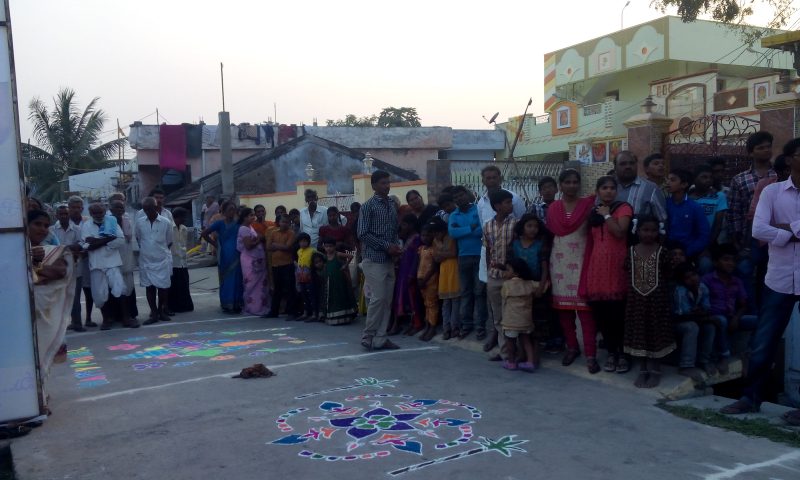
Image from https://commons.wikimedia.org/wiki/File:Rangoli_Competition_on_the_Day_of_Bhogi.jpg Video by Channel Anjana Telugu Vlogs -
Rangoli has transcended its Indian origins to become a source of inspiration and cultural exchange worldwide. Its aesthetic beauty and cultural significance have left a lasting impact that reaches far beyond India's borders.
Artists and designers from diverse backgrounds have drawn inspiration from Rangoli's vibrant colors and meticulous designs, incorporating elements of this art form into their creations. This influence is evident in various art forms, from paintings to textiles and contemporary design.
In multicultural societies, Rangoli has found its place in celebrations and festivals that promote diversity and cultural understanding. Indian communities in countries like the United States, the United Kingdom, and Canada use Rangoli to showcase their cultural heritage and foster cross-cultural connections.
Rangoli's mathematical and geometric aspects have intrigued educators worldwide, serving as a teaching tool for concepts related to symmetry, geometry, and patterns. Additionally, its meditative qualities have attracted individuals seeking mindfulness practices and stress reduction techniques.
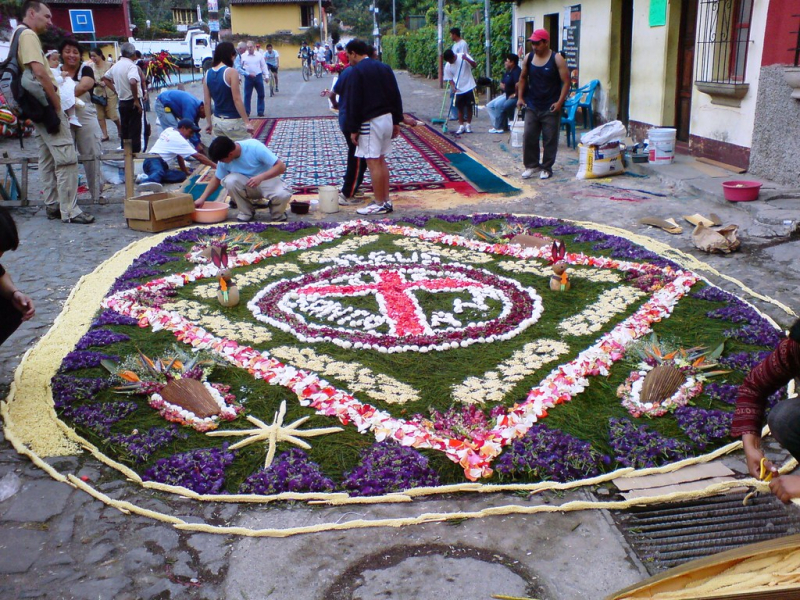
Image from https://www.flickr.com/photos/robertourrea7/2308578010/ Video by TEDx Talks -
The art of Rangoli, deeply rooted in Indian culture, holds fascinating mathematical connections that have attracted mathematicians and educators. Reflection symmetry, also known as mirror symmetry, is evident in many Rangoli designs. Artists create a pattern on one side of an axis that is perfectly mirrored on the other side.
Translational symmetry is observed when Rangoli patterns can be shifted or translated along a particular direction to create a new identical pattern. This concept relates to the geometric concept of translation, allowing students to explore the idea of shifting shapes without altering their appearance.
Moreover, the use of intricate geometric shapes and patterns in Rangoli provides an excellent opportunity for students to learn about shapes, angles, and spatial relationships. Educators have used Rangoli as a practical and engaging way to teach mathematical concepts, making learning both enjoyable and visually stimulating.
Incorporating Rangoli into mathematical education not only deepens students' understanding of mathematical principles but also fosters an appreciation for the cultural and artistic significance of this ancient tradition. It showcases the profound ways in which art and mathematics intersect, highlighting the universal language that both disciplines share.
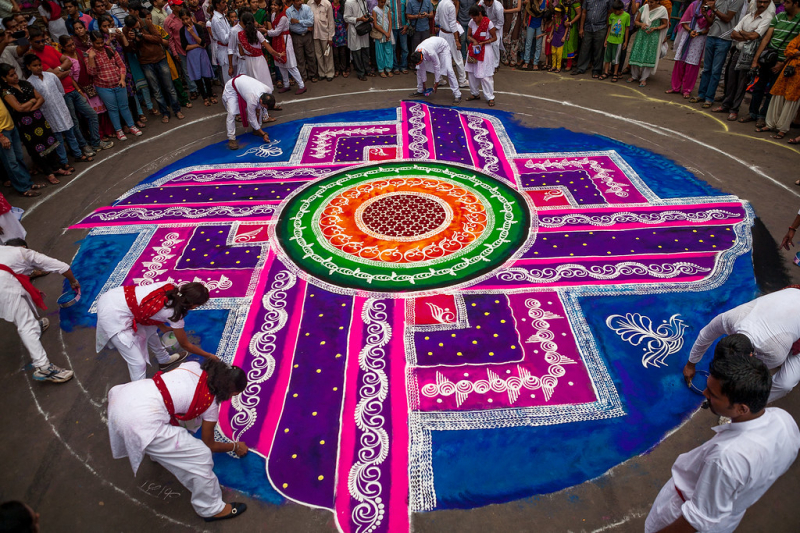
Screenshot of https://www.flickr.com/photos/sandeepachetan/12293893044/in/photostream/ Video by Innovation for Youth
























